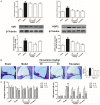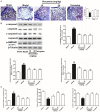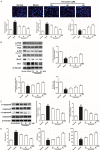Vincamine exerts protective effect on spiral ganglion neurons in endolymphatic hydrops guinea pig models
- PMID: 30662616
- PMCID: PMC6291722
Vincamine exerts protective effect on spiral ganglion neurons in endolymphatic hydrops guinea pig models
Abstract
The aim of this study was to investigate the protective effects of vincamine in endolymphatic hydrops (ELH). After ELH guinea pigs treated by vincamine, the concentration of VAP in plasma, and the levels of cAMP, MDA, SOD, GSH-Px in right cochlea were measured using spectrophotometric method. The V2R, NMDAR1, p-NMDAR1, AQP2, p-AQP2, caspase3/9 and c-caspase3/9 expressions in right cochlea were detected using western blot analysis. The cochlear hydrops degree and SGNs density were evaluated by hemotoxylin and eosin staining (HE) test. Normal hearing and vestibular function were warranted by the tests of auditory brainstem response (ABR) and electronystagmography (ENG). After glutamate-injured SGNs treated with vincamine, the MDA, SOD GSH-Px, NGF, BDNF, NT3, NT4 and Trks levels were measured. Meanwhile, the Bcl2, Bax, NMDAR1, p-NMDAR1, PI3K, p-PI3K, Akt, p-Akt, caspase3/9 and cleaved-caspase3/9 expression levels were detected. Furthermore, the viability, apoptosis and necrosis of SGNs were tested by MTT and Hoechst/PI staining methods. The results indicated that vincamine could significantly inhibit the expression levels of cAMP, MDA, V2R, p-NMDAR1, p-AQP2 and c-caspase-3/-9 in cochlea, alleviate the cochlear hydrops degree, regulate the audiological and vestibular dysfunctions. The SGNs density, SOD and GSH-Px levels were also increased by vincamine. In vincamine-treating groups, the MDA, Bax, p-NMDAR1, and c-caspase3/9 levels were observably decreased, while SGNs survival, SOD, GSH, NGF, BDNF, NT3, NT4, Trks, Bcl2, p-PI3K, p-Akt expressions were improved. The present study indicated a novel use of vincamine in suppressing ELH formation by down-regulating the VAP/AQP2 signaling pathway. It also manifested that vincamine exerted protective effects on hearing via improving neurotrophin-dependent PI3K/Akt signaling pathway in SGNs.
Keywords: Meniere’s disease; PI3K/Akt; VAP/AQP2; endolymphatic hydrops; vincamine.
Conflict of interest statement
None.
Figures





References
-
- Lopez-Escamez JA, Carey J, Chung WH, Goebel JA, Magnusson M, Mandalà M, Newman-Toker DE, Strupp M, Suzuki M, Trabalzini F, Bisdorff A Classification Committee of the Barany Society; Japan Society for Equilibrium Research; European Academy of Otology and Neurotology (EAONO); Equilibrium Committee of the American Academy of Otolaryngology-Head and Neck Surgery (AAO-HNS); Korean Balance Society. Diagnostic criteria for Meniere’s disease. J Vestib Res. 2015;25:1–7. - PubMed
-
- Thai-Van H, Bounaix MJ, Fraysse B. Meniere’s disease: pathophysiology and treatment. Drugs. 2001;61:1089–1102. - PubMed
-
- Maekawa C, Kitahara T, Kizawa K, Okazaki S, Kamakura T, Horii A, Imai T, Doi K, Inohara H, Kiyama H. Expression and translocation of aquaporin-2 in the endolymphatic sac in patients with Meniere’s disease. J Neuroendocrinol. 2010;22:1157–1164. - PubMed
-
- Naganuma H, Kawahara K, Tokumasu K, Satoh R, Okamoto M. Effects of arginine vasopressin on auditory brainstem response and cochlear morphology in rats. Auris Nasus Larynx. 2014;41:249–254. - PubMed
-
- Foster CA, Breeze RE. Endolymphatic hydrops in Meniere’s disease: cause, consequence, or epiphenomenon? Otol Neurotol. 2013;34:1210–1214. - PubMed
LinkOut - more resources
Full Text Sources
Research Materials
Miscellaneous
